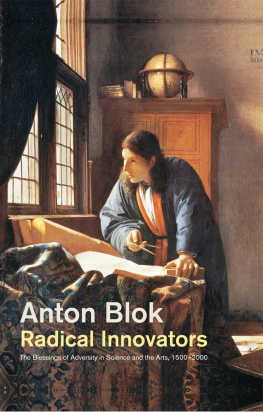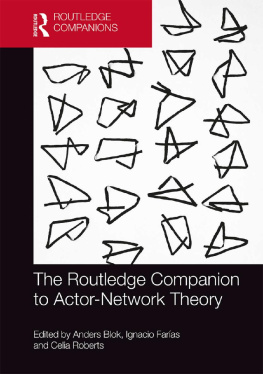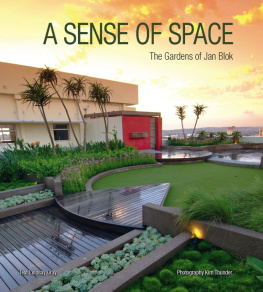Contents
Guide
Pages

Radical Innovators
The Blessings of Adversity in Science and the Arts, 15002000
Anton Blok
polity
First published in Dutch as De vernieuwers, Anton Blok, 2013
This English edition Polity Press, 2017
This publication has been made possible with financial support from the 
Dutch Foundation for Literature
Polity Press
65 Bridge Street
Cambridge CB2 1UR, UK
Polity Press
350 Main Street
Malden, MA 02148, USA
All rights reserved. Except for the quotation of short passages for the purpose of criticism and review, no part of this publication may be reproduced, stored in a retrieval system, or transmitted, in any form or by any means, electronic, mechanical, photocopying, recording or otherwise, without the prior permission of the publisher.
ISBN-13: 978-1-5095-0555-5
A catalogue record for this book is available from the British Library.
Library of Congress Cataloging-in-Publication Data
Names: Blok, Anton.
Title: Radical innovators : the blessings of adversity in science and the arts, 1500-2000 / Anton Blok.
Other titles: Vernieuwers. English
Description: English edition. | Cambridge : Polity, 2016. | Includes bibliographical references and indexes.
Identifiers: LCCN 2016016765 (print) | LCCN 2016025562 (ebook) | ISBN 9781509505517 (hardcover : alk. paper) | ISBN 1509505512 (hardcover : alk. paper) | ISBN 9781509505524 (pbk. : alk. paper) | ISBN 1509505520 (pbk. : alk. paper) | ISBN 9781509505548 (mobi) | ISBN 9781509505555 (epub)
Subjects: LCSH: Science--History. | Art--History. | Anthropology.
Classification: LCC Q125 .B582713 2016 (print) | LCC Q125 (ebook) | DDC 509/.03--dc23
LC record available at https://lccn.loc.gov/2016016765
The publisher has used its best endeavours to ensure that the URLs for external websites referred to in this book are correct and active at the time of going to press. However, the publisher has no responsibility for the websites and can make no guarantee that a site will remain live or that the content is or will remain appropriate.
Every effort has been made to trace all copyright holders, but if any have been inadvertently overlooked the publisher will be pleased to include any necessary credits in any subsequent reprint or edition.
For further information on Polity, visit our website: politybooks.com
PREFACE AND ACKNOWLEDGMENTS
This book investigates how people from different backgrounds and in different circumstances could accomplish a breakthrough in science or the arts. What did these pioneers, along with their differences, have in common? Which forces were operating in the development of a new point of view?
Insofar as these questions have been raised before, scholars have searched for an answer in the area of talent, intelligence, and other inborn gifts. Subsequent longitudinal research, however, has shown that highly intelligent students are not always also highly creative.
To anticipate the outcome of this research, nearly all the pioneers were confronted with early adversity resulting in social exclusion. Adversity could take different forms, including illegitimate birth, parental loss, parental conflict, the fathers bankruptcy, chronic illness, minority status, poverty, physical deficiencies, detention, and exile. In histories of science and the arts, some of these conditions or factors have been explored to explain radical innovation, but mostly in the form of one-factor analysis, including chronic illness, parental loss, and birth order. What all the different forms of adversity turn out to have in common justifying the use of one common denominator is social exclusion, which implies the strategic position of the outsider. This comes down to Butterfields recommendation of handling the same bundle of data as before, but placing them in a new system of relations with one another by giving them a different framework.
The research for this book has taken about ten years. An early interest in biographies (at high school in the 1950s) could be turned into a systematic inquiry of a substantial collective biography. Second, I had to familiarize myself with the state of the art: the discussion among historians and psychologists on groundbreaking work of the great pioneers in science and the arts active between about 1500 and 2000. For a better understanding of the roots of radical innovation in these fields, the present book argues for a more comparative sociological and anthropological approach focused on the social position of pioneers: their place in sets of social relationships, whether institutional, conjunctural, or both.
In writing this book, I have incurred numerous debts to friends and colleagues. An early single bibliographical reference had far-reaching consequences for the argument of this project. In a brief exchange, visiting classicist Karin Bassi referred me to Symes statement on the position of Thucydides: exile may be the making of an historian. That is patent for Herodotus and Polybius. If a man be not compelled to leave his own country, some other calamity a disappointment or a grievance may be beneficial, permitting him to look at things with detachment, if not in estrangement. This observation dovetailed with the overall detachment and aloofness that mark the habitus of the radical innovators outlined in the collective biography.
I am also indebted to Peter Burke, who carefully read the Dutch version of the book shortly after its publication in the fall of 2013. His letter provided several corrections of names and places as well as pointing out the absence of some outstanding examples of radical innovators who had been affected by early adversity, including Leonardo da Vinci (illegitimate birth, homosexual), Michelangelo (parental conflict, homosexual), and itinerant Thorstein Veblen (migr, minority status, poverty). The book certainly shows omissions but this is perhaps inherent, even in a substantial collective biography that covers a long period of time. The foremost intention was to search for recurrent patterns in the collective biography and to make sense of them: explaining that following adversity and social exclusion, radical innovators tended to be outsiders having less to lose, they could take more risks than their established colleagues, who tended to stick to mainstream views and practices.
Omissions may provide test cases. I hesitated to include the great Dutch painter Johannes Vermeer (163275), a contemporary of Spinoza: little is known about Vermeers youth. Research over more than a century produced more questions than answers, as Montias notes in his painstaking biography of Vermeer and his milieu in which he is careful to identify conjectures and not let them be confused with solid facts.
The same year Vermeer entered St. Lukes Guild as a master painter. The local guild became the center of his public life. Vermeer kept a low profile. He lived with his wife (who gave him no fewer than fifteen children) in the big house of his wealthy mother-in-law, where he also had his studio. She took a genuine liking to him and from the beginning financially and materially supported her daughters family. Biographer Montias notes that Vermeers absence from Delfts notarial archives makes it seem as if he wished to withdraw from civil society, perhaps because he was engrossed in his work or because he had joined a religious minority subject to prejudice and discrimination.



![Lourens Blok - Death Pulls a Doublecross [= Cowards Kiss]](/uploads/posts/book/873811/thumbs/lourens-blok-death-pulls-a-doublecross-cowards.jpg)











